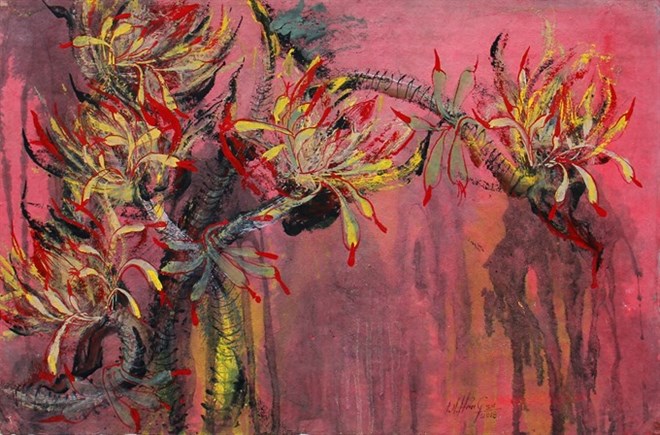
An exhibition entitled Chuoi Rung (Wild Banana) featuring nearly 40 artworks by painter Tran Ngoc Hung is opened to public in Hanoi.
Wild Banana showcases a new series of paintings made by Hung over more than 10 years, featuring powder colours on Vietnamese traditional do (poonah) paper. This is the first time the artist has debuted his do paintings.

Wild Banana series by artist Tran Ngoc Hung.(Source: VNA)
"I was inspired by wild banana a long time ago when I was a
student having field trips to the northern mountainous provinces of Hoa Binh
and Son La La," said Hung. "I focus on expressing wild banana flowers
which wither for fruit banana."
Hung studied lacquer at the Industrial Fine Arts University and works with both
lacquer and poonah. The poonah paintings combine traditional materials of the
paper and powered colours in a modern style.
Poonah paper is made from the bark of the poonah tree which can be found in
Vietnam’s northern region. The paper has been used widely since the 18th
century in Vietnamese folk art such as Dong Ho, Hang Trong and Kim Hoang paintings.
"I want to recover traditional poonah paper and draw in the medium of
powder colours which were used by Vietnamese artists from 1990s and
before," Hung said. "Nowadays, almost no artist wants to draw with
powder colours because it is difficult to mix."
"Thanks to the paper’s unique characteristics -- durable and resilient, it
has to go through a series of meticulous and complicated steps which are
carried out manually," Hung said.
He buys the paper at the handicraft village of Dong Cao in Bac Ninh province,
and he dyes the paper with bright and warm tones before he draws.
The wild banana flower theme is a way for Hung to reveal his findings on visual
art language and inner feelings.
"I haven’t had chance to see wild banana flower in Vietnam but through the
beautiful paintings by artist Hung I feel the beauty and charming of this
flower," said Park-hyejin, the Korean Culture Centre’s director in Hanoi.
"I’m surprised that do paper is similar to Korean hanji paper which makes
each painting more attractive. I hope the exhibition is a chance for Korean and
Vietnamese people to discover the natural beauty made by a talented
artist."
Hung currently works at Vietnam Fine Arts Museum. He has had many group
exhibitions in Vietnam and abroad including in Italy in 2013 and China in 2012.
His first solo was held at Vietnam Fine Arts Museum in 2015.
The poonah painting exhibition will run until September 29 at the Korean
Culture Centre.
Source: VNA
With an increasingly vibrant and widespread emulation movement aimed at building cultured residential areas and cultured families, Yen Thuy District has been making steady progress toward improving both the material and spiritual well-being of its people, while fostering a civilized, prosperous, beautiful, and progressive community.
Once lacking recreational spaces and community facilities, Residential Group 2 in Quynh Lam Ward (Hoa Binh City) has recently received attention for the construction of a new, spacious, and fully equipped cultural house. The project followed the model of state support combined with public contributions in both labor and funding.
The "All people unite to build cultural life" movement, which has been effectively integrated with Kim Boi district’s socio-economic development goals, is fostering a lively spirit of emulation across local residential areas, hamlets, villages, public agencies, and enterprises. In addition, through the initiative, traditional cultural values are being preserved and promoted, while community solidarity and mutual support in poverty reduction and economic development are being strengthened.
A working delegation of the Hoa Binh provincial People’s Committee led by its Permanent Vice Chairman Nguyen Van Toan on June 11 inspected the progress of a project to build the Mo Muong Cultural Heritage Conservation Space linked to tourism services in Hop Phong commune, Cao Phong district.
Born and growing in the heroic land of Muong Dong, Dinh Thi Kieu Dung, a resident in Bo town of Kim Boi district, in her childhood was nurtured by the sweet lullabies of her grandmother and mother. These melodies deeply imprinted on her soul, becoming an inseparable part of her love for her ethnic group's culture. For over 20 years, this love for her hometown has driven Dung to research, collect, and pass down the cultural values of the Muong people to future generations.
In the final days of May, the Ethnic Art Troupe of Hoa Binh Province organized performances to serve the people in remote, mountainous, and particularly disadvantaged areas within the province. These were not just ordinary artistic shows, but they were the meaningful journeys aimed at spreading cultural values, enhancing the spiritual life of the people and contributing to the preservation of ethnic minority cultural identities.



